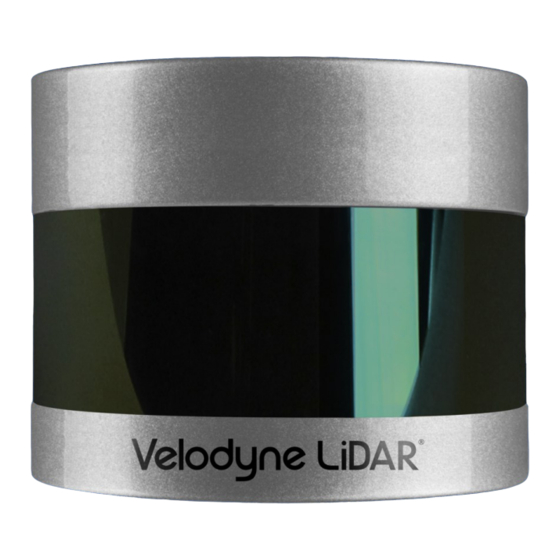
Velodyne VLP-32C 360-degree Lidar Sensor Manuals
Manuals and User Guides for Velodyne VLP-32C 360-degree Lidar Sensor. We have 2 Velodyne VLP-32C 360-degree Lidar Sensor manuals available for free PDF download: User Manual
Velodyne VLP-32C User Manual (138 pages)
Brand: Velodyne
|
Category: Accessories
|
Size: 20 MB
Table of Contents
-
-
-
Variants22
-
-
-
-
-
-
-
-
-
Definitions54
-
Azimuth55
-
Data Block55
-
Data Point55
-
Time Stamp55
-
-
-
-
-
Info Screen73
-
-
-
Top:hv78
-
Bot:i_Out80
-
Bot:pwr_1_2V80
-
Get Snapshot82
-
Reset System83
-
Set DHCP84
-
Set Gateway84
-
Set Netmask84
-
-
-
-
-
-
Features111
-
Install Veloview112
-
-
-
Laser Patterns120
-
-
Introduction123
-
Background123
-
PPS Qualifier124
-
GPS Qualifier125
-
Application125
-
Logic Tables125
-
-
-
Phase Lock127
-
Field of View130
-
-
-
-
Method One132
-
Method Two132
-
Method Three132
-
Method Four133
-
-
Advertisement
Velodyne VLP-32C User Manual (136 pages)
Brand: Velodyne
|
Category: Accessories
|
Size: 14 MB
Table of Contents
-
Method2
-
Method3
-
-
Variants22
-
-
-
-
-
Definitions54
-
Data Point55
-
Azimuth55
-
Data Block55
-
Time Stamp55
-
-
MAC Address73
-
Info Screen75
-
Top:hv80
-
Top:pwr_5V81
-
Top:pwr_2_5V81
-
Top:pwr_3_3V81
-
Top:pwr_Raw82
-
Bot:i_Out82
-
Bot:pwr_V_In84
-
Get Snapshot84
-
Reset System85
-
Set Netmask86
-
Set Gateway86
-
Set DHCP86
-
-
-
Features108
-
Install Veloview109
-
-
-
Introduction121
-
Background121
-
PPS Qualifier122
-
Require PPS Lock122
-
Delay123
-
GPS Qualifier123
-
Application123
-
Logic Tables123
-
-
-
Phase Lock125
-
Field of View128
-
-
-
Defaults132
Advertisement

